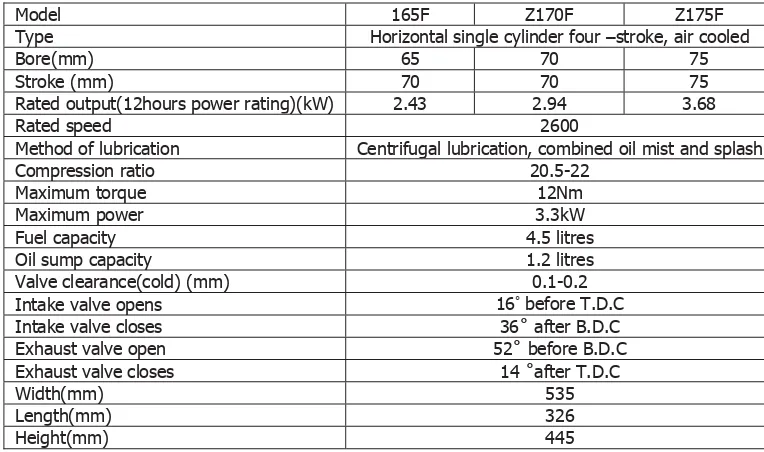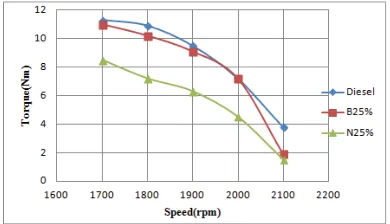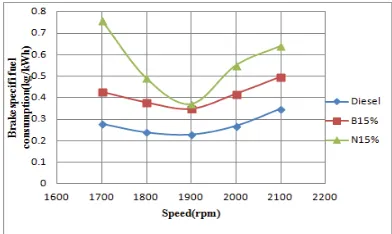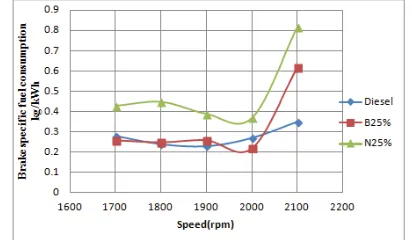Performance of Soybean and Neem Methyl Esters as
Biodiesel on Diesel Engine
Joseph .S. Enaburekhan
Department of Mechanical Engineering, Bayero University, Kano-Nigeria
Shehu Bello
Department of Mechanical Engineering Technology, Nuhu Bamalli Polytechnic, Zaria-Nigeria
Doi:10.5901/ajis.2013.v2n13p47
Abstract
To study the feasibility of using two local produced plant oils Soybeans (Glycine max, Family: Fabaceae), and Neem (Azadirachta indica, Family: Meliaceae) as diesel substitute, a comparative study on their combustion characteristics on a C.I. engine were made. Experimental investigations were carried out on diesel engine with bio diesel blends of Soybeans oil Methyl Esters and Neem Oil Methyl Esters .The engine used for the experiments was single cylinder four stroke air cooled. Soybeans Methyl Esters and Neem Methyl Esters were derived through transesterification process and parameters of transesterification were optimized. The blending was done with pure diesel in the ratio of 15:85(B15 and N15), 20:80 (B20 and N20), 25:75 (B25 and N25), by volume. Pure diesel was used as control. Tests were carried out to examine their engine performance of different blends in comparison to diesel. From the experimental results it was shown that B20 has more closer performance to diesel, followed by B25%, in terms of torque, brake power and specific fuel consumption, with B20% giving a higher toque above that of diesel at 1800rpm. While Neem biodiesel blends have poor performance. These studies have revealed that soybean oils at 20% and 25% blend with diesel can be used as a diesel substitute without bringing any modifications in the engine.
Keywords: Soybean methyl ester,Neem methyl ester, torque, brake power, brake specific fuel consumption
1. Introduction
used is of importance, parameters most importantly torque, brake power, exhaust temperature, specific fuel consumption and efficiency at varying loads with respect to the speed need to be investigated and compare to that of conventional petroleum diesel, this finally provides the correct biodiesel blend to be used without problem. Jatropa is mostly so far the most widely used biodiesel feed stock, despite its unavailability and cost(Kanothe ,Gerpen ,&Krahl.2004) Alternatively, in this work, biodiesels made from Soybean and Neem oils with blend ratios of petroleum diesel of 15:85,20:80, and 25:75,i.e B15%,B20%, and B25% were studied in terms of torque, brake power and specific fuel consumption at varying speeds for different loading conditions. In order to find the most suitable biodiesel feedstock apart from widely used Jatropa, and correct blend ratio whose engine performance will be equal or better than that of petroleum diesel at less cost. Initially the engine was run by diesel fuel. Then, the experiments were repeated replacing diesel by different biodiesel blends, doing so various engine performances were obtained, analyzed and reported.
2. Methods
The pure samples of biodiesels were preferred from Soybean and Neem oils by transesterification process(ASTM 6751), subsequently the blends B15%,B20%,B25% were made from characterized conventional diesel(ASTM 975) with these biodiesels. The analytical experimental procedure was carried out using four stroke air cooled diesel engine TQUIPMENT; model 165F. Massflowrate,torque,brake horse power,specific fuel consumption were determined at varying engine speed. Graphs of torque brake horsepower and specific fuel consumption versus speed were drawn, for conventional diesel,B15%,B20% and B25% blend ratios of Soybean and Neem biodiesels respectively.
Table 1. The TQUIPMENT diesel engine specifications.
Model 165F Z170F Z175F
Type Horizontal single cylinder four –stroke, air cooled
Bore(mm) 65 70 75
Stroke (mm) 70 70 75
Rated output(12hours power rating)(kW) 2.43 2.94 3.68
Rated speed 2600
Method of lubrication Centrifugal lubrication, combined oil mist and splash
Compression ratio 20.5-22
Maximum torque 12Nm
Maximum power 3.3kW
Fuel capacity 4.5 litres
Oil sump capacity 1.2 litres
3. Procedures
3.1 Engine Test Setup
The experiment setup consisted of engine test bed, whose specification was given in Table 1, with fuel supply from the tank. The fuel followed through a graduated pipette of sectioned volumetric capacities of 8ml,16ml, and 32ml. For this experiment, 8ml volumetric capacity was used of each sample ,stop watch was used to measure the time within which 8ml of a sample at varying speed and torque was consumed, upon which volumetric and mass flow rates were calculated.torque was directly read,brake power and fuel consumption were calculated from performance equations. A hydraulic brake dynamometer coupled with the engine was used to load the engine. Load was varied by changing the water flow rate to the dynamometer to allow an increment of 100rpm to the engine speed. The exhaust temperature was measured using thermocouple. This set up was used throughout the experiments. Each time a sample finished, the fuel system was flushed using the succeeding sample, before it was used .
3.2 Engine performance Equations
3.2.1 Mass flow rate
݉ൌ
௧ݔߩݔμ (Bugaje, Higima,& Umar,2011) Where:
m = Mass Flow Rate of Fuel (kg/s) V = Volume Flow Rate of Fuel (cm3/s)
Ǐ= Density of Water (kg/cm3)
μ= Specific gravity (kg/cm3)
3.2.2 Torque of the engine
Torque is the available work on the output shaft of the engine it is measured by dynamometer, it is from the torque out put power is calculated. Torque is given as
ܶ ൌ ܨܺ݀
Where F= load applied (N) b= perpendicular distance from the point of action
3.2.3 Brake Power
The available power on the output shaft of the engine is the brake power, it is calculated from the torque measured by dynamometer.
ܤ ൌ ଶగே்
---- (Giri, 2009)
Where Bp= brake power (kW) N= angular speed (rpm) T= torque developed by the shapt in (NM)
3.2.4 Brake Specific fuel consumption
It is defined as the ratio of mass flow rate of fuel into the engine per second it is given as: ݂ܵܿ ൌଷ௫
4. Results
Figure 1. Comparison of torque and Speed for Diesel, B15% and N15%.
Figure 2. Comparison of Torque and Speed for Diesel, B20% and N20%.
Figure 4. Comparison of Brake horse power and Speed for Diesel, B15% and N15%.
Figure 5. Comparison of Brake horse power and Speed for Diesel, B20% and N20%.
Figure 8. Comparison of Brake specific fuel consumption with Speed for Diesel, B20% and N20%
Figure 9. Comparison of Brake specific fuel consumption with Speed for Diesel, B25% and N25%
5. Discussion
5.1 Performance Curve in terms of Torque
This section discusses the performance analysis of the diesel engine in terms of torque produced by the engine, when pure petroleum diesel and biodiesel blends of B15%, B20%, B25%, N15%,N20%,and N25 %of Soybean and Neem biodiesels were used as fuel. From Figures 1-3, it was observed that torque generally increased with the increased in engine speed, up to a certain speed limit then starts decreasing. This phenomena agrees with similar work of (Deepanraj, Dhanesh.,& Salki 2011). For all the biodiesel blends, it was only B20% produced efficient torque fairly above that of petroleum diesel, at a speed of about 1800 rpm Fig.2, though B25% blends produced torque similar to that of petroleum diesel but it declined at 1700 rpm, Fig.3. The other blends ratios of Soybean and Neem biodiesels indicated a poor performance in terms of torque compared to petrol diesel .Biodiesel blend of B20% and B25% are the good alternatives to petroleum diesel,. With B20% showing peak torque of 11.2Nm at a speed of 1800 rpm Fig.2, and conventional diesel produced a torque of 10.3Nm at that speed.
5.2 Performance Curve in term of Brake Power.
,&Islam, 2007). With respect to this analysis, poor brake power was seen with B15%,N15%,N20% and N25% blends of biodiesels compared to diesel. B20% and B25% produced an efficient brake power almost above that of petroleum diesel in the case B20% at 1800rpm see Fig 5. B20% and B25% are the good alternatives to conventional diesel .
5.3 Performance Curve in terms of Brake Specific Fuel Consumption
This section discussed the performance analysis of the diesel engine in terms of brake specific fuel consumption produced by the engine, when pure petroleum diesel and biodiesel blends of B15%, B20%, B25%, N15%,N20% and N25% of Soybean, and Neem biodiesels Figures 7-9 were used as fuels. From the curves it was observed that, brake specific fuel consumption increased with the increase in biodiesel percentage in the blends, specific fuel consumption is the inverse of thermal efficiency (Deepanrej et.al 2011). It was also seen that, consumption is higher at lower speed below 1700 rpm and reduced within the range of 1800 rpm to 2000 rpm. Blends ratios of B15%, B25%, N15%, N20% and N25% of Soybean, and Neem biodiesels showed a higher consumption rate compared to petroleum diesel. B20% was seen having similar consumption rate with petroleum diesel, while NB20% was seen to have higher consumption rate. Therefore in terms of brake specific fuel consumption B20% is the best alternative. B25% blends ratios also have higher consumption rate more than B20% at higher speed beyond 2000 rpm.
6. Conclusion
B20% produced efficient torque, brake power and specific fuel consumption similar to that of petroleum diesel, followed by B25%. Neem biodiesel generally have poor performance in terms of torque, brakepower and fuel consumption this due to higher fatty acid content more than that of Soybean biodiesel. The best engine performance for Soybean biodiesel operates at the engine speed of 1800rpm. The overall analysis has shown that B20% is the most efficient substitute to petroleum diesel, followed by B25%.
References
Abdul, M. Jon, H., & Van G. (2001). ‘The Effect of Biodiesel Oxidation on Engine Performance and Emissions’, International Journal of Biomass and Bio Energy, 20 317-325.
Aqeel, A. Gholamreza, Z. and Haslenda,H. (2011).Progress and challenges in utilization of palm oil biomass as fuel for decentralized electricity generation. Renew. Sustain. EnergyRev, 15 574-583 Bugaje,I.M.Umar,B,HighinaB.K,(2011).Performance of biodiesel compared to conventional diesel fuel in
stationary internal combustion engines .Journal of applied technology in environmental sanitation, 2, 199-205
Deepanraj,B. Dhanesh,C. Salki,R.(2011) Use of palm oil biodisel blends as a fuel for compression ignition engine . American Journal of Applied Science 8(11): 1154-1158, .
Ehsan, M.Taposh R. M.Islam, M.M.(2007). Running a diesel engine with biodiesel Proceedings of the7thInternational Conference on Mechanical Engineering, 7 34-38.
Giri, N.K. 2009 Automobile technology Khanna Publishers India 2nd Edition 156-178
Hossain, A.Boyce,A.N. (2009). Comparative study of biodiesel production from pure palm oil and waste palm oil. Arab Gulf J. Sci. Res. 27(1-2): 3338
Kanothe ,G., J.V. Gerpen and J. Krahl. (2004). Biodisel hand book. AOCS press Illinois.



